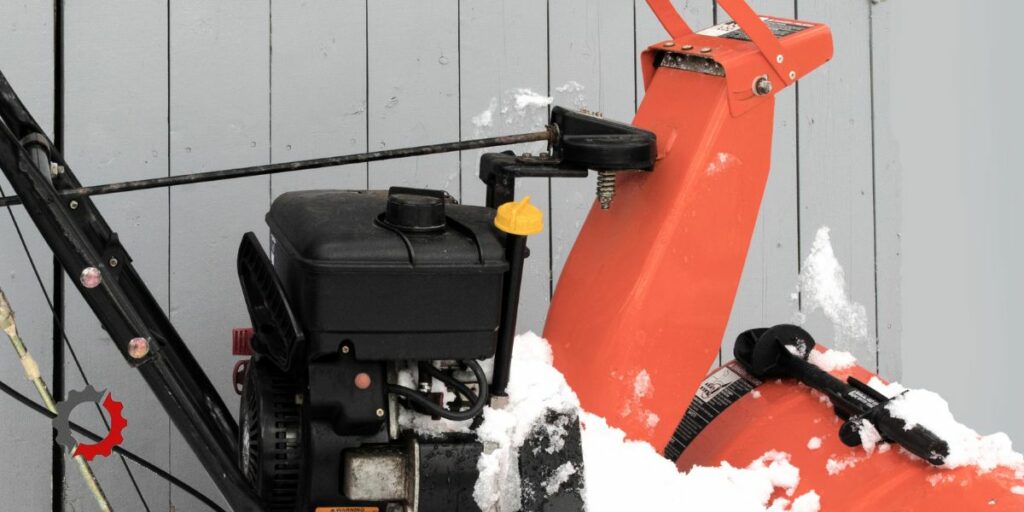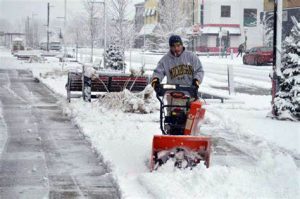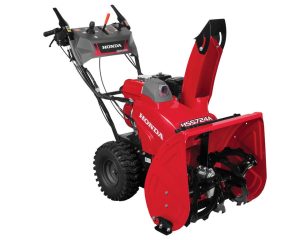Snowblower Turns Over But Won’t Start for These 6 Reasons
A snowblower that won’t turn on during a snowfall is a nightmare. For this reason, I compiled a list of the most typical reasons for a snowblower to turn over but fail to start.
Conditions such as a stuck or improperly positioned choke, a faulty spark plug, old gas, a clogged fuel line, a dirty carburetor, or a blocked fuel vent in the gas cap will cause the snowblower to crank but fail to start.
If you want to know how to properly maintain and operate your snow thrower, you should read the manual.

Snowblower turns over but won’t start
Table of Contents
6 Causes of Your Snowblower Turning Over But Not Starting
Choke Got Stuck or Wasn’t Set Correctly
By adjusting the amount of air permitted to combine with the fuels during combustion, the snowblower may be started and kept running. Most snow throwers include a choke lever, but some have an inconveniently hidden automatic choke.
A cold engine uses more gasoline but less air to do the same work as a warm one. The air intake is blocked by moving the choke lever to the on position.
When the engine is up to temperature and running smoothly, the choke lever should be moved to the open position. The snowblower will cease functioning once the motor has begun and heated up except if the lever is moved.
When the motor is warm, the snowblower will start only if the choke is open.
Whether the engine won’t start after you’ve made sure the choke levers are set properly, check to see if the choke cable may be adjusted. Use carburetor cleaning to unstick the choke or cable.
Snowblower Spark Plug Is Dirty
To get rid of the spark plug, you’ll need a socket wrench measuring either 3/4″ or 5/8″. The type of snowblower engine determines the necessary size. Check the state of the plug.
A damaged or severely dirty plug could prevent the engine from starting and running since it would not provide the spark that is required. Inspect the spark plug for signs of damage, such as a darkened, carbon-coated tip, a burned electrode, or a broken porcelain electrode.
When any of these problems arise, a new spark plug should be installed. If the plug is in good shape, you can use a wire brush to clean it.
When the spark plug gap is just right, you can switch them out. The spark plug cable is then fastened.
If you want your snowblower to work properly, you should replace the spark plug before the first snowfall of the season.
Snowblower with Old Fuel
It doesn’t take long for gas to lose its potency when it’s just pumped. It may start to break down as soon as 30 days just after you buy it. Varnish and gummy deposits left over from previous usage of fuel lower fuel efficiency and ultimately lead to component failure.
Therefore, you should always be sure to acquire new gas and use it within a month. Don’t risk it; don’t use gas that contains ethanol. To ensure proper engine operation, fill up with fuel that has an octane value of 87 or above and contains no more than 10% ethanol.
A fuel siphon pump can be used to remove stale gas from the tanks of your snowy thrower. Along with fresh fuel, using a gasoline stabilizer like Sea Foam or STA-BIL can help flush out the fuel system and cut down on moisture. In this piece, I’ll go into greater depth about how fuel additives can improve the performance of snow blowers.
First, start up the snow buster and allow it to run for a bit to distribute the fuel and fuel additive. If you’re still having problems kicking it into gear after reading this, there may be more factors to consider.
Snowblower Fuel Line Clogged
Next, proceed to the carburetor by following the fuel line that exits the fuel tank. Look for any kinks that may be preventing the snowblower from starting by impeding the flow of gasoline.
If you don’t discover any kinks, look for a fuel line obstruction. To begin, use the fuel shut-off valve or fuel pinch-off pliers to stop the flow of fuel. After that, disconnect the carburetor’s fuel line.
Put this line inside a fuel collection container. Restart the fuel supply and keep an eye on the fuel flow leaving the fuel line. Replace the gasoline line if the flow is still good. If not, stop the fuel flow and disconnect the snowblower’s fuel line.
In the line, spray carburetor cleaner. This is done in an effort to clear the obstruction. The clog can then be removed by clearing the line by blowing compressed air through it. Until the clog is gone, keep using compressed air and carburetor cleanser.
Once the obstruction has been cleared, reinstall the gasoline line. If the limitation is not gone or you discover the fuel line is old and starting to crack, replace it with a new one.
Snowblower Carburetor that is filthy
The carburetor’s job is to combine gas and air so that they can burn in the engine. Your snowblower won’t start if the carburetor isn’t functioning properly.
Old gas is much too frequently the major cause of a carburetor not working properly. A varnish left over from used fuel might clog the fuel jet or make internal parts stick.
If the carburetor stops operating, you should try cleaning it, replacing any broken parts, or buying a new one.
Do the following things before disassembling your snowblower’s carburetor:
- Verify that the fuel is flowing properly to the carburetor.
- Start the snow thrower after spraying some carburetor cleaners into the air intake. If your carburetor performs well while burning carburetor cleaners but sluggishly or turns off once the cleaner is gone, it’s probably unclean.
- Continue cleaning or replacing the carburetor after it has been disassembled.
Fuel Vent Plugged in the Snowblower Gas Cap
Venting the fuel tank is necessary to equalize the pressure within with the outside air. A snowblower’s vent might be located in its gas cap.
When the vent becomes blocked, the gas tank develops a vacuum. This vacuum prevents gas from entering the carburetor. A lack of gas prevents the snowblower from starting, despite turning over.
To determine if releasing the gas cap and trying to ignite the snowblower will solve the problem, try doing so. It may be as simple as forgetting to turn the gas cap.
Ensure the broken cap is the one you’re replacing by continuing to use the snowblower as you do so. If it sputters, turns off, and won’t turn back on unless you release the cap, you need to get a new one.






